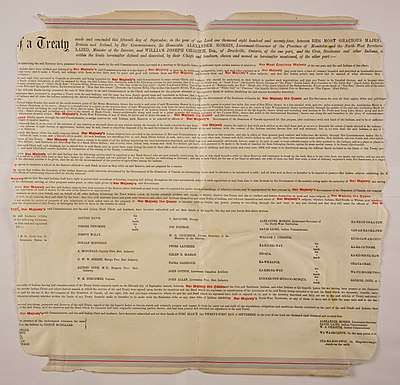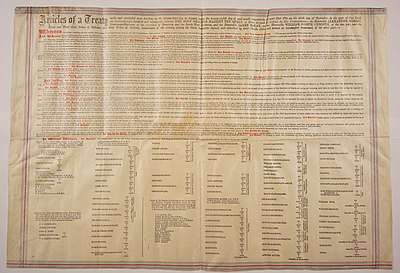Treaty rights
Treaty rights are rights conferred through the signature of a treaty, e.g. the Svalbard Treaty.
| Part of a series on |
| Indigenous rights |
|---|
| Rights |
| Governmental organizations |
| NGOs and political groups |
| Issues |
| Legal representation |
| Category |
| Indigenous peoples in Canada |
|---|
|
|
History
|
|
Politics
|
|
Culture
|
|
Demographics
|
|
Religions |
|
Index
|
|
Wikiprojects Portals
WikiProject
First Nations Inuit Métis |
In the United States and Canada, treaty rights specifically refer to rights reserved by indigenous peoples when they signed Indian treaties with settler societies in the wake of European colonization. This applies to the rights of Alaska Natives and Native Americans in the United States and First Nations in Canada.[1] It also applies to a smaller number of Inuit and Metis in Canada who have entered into treaties. By extension, a treaty Indian is a Canadian legal term for a person who has inherited such rights.
Treaty rights are not the only rights claimed by indigenous peoples. Indigenous people claim inherent rights to self-determination, which implies that they be recognized as rights-bearing groups (called "tribes," "bands," or "nations" depending on the place and time) capable of self-determination and cultural survival.[2] Once the United States government recognizes that there is another body corporate with legal personality capable of making binding agreements on behalf of its members, then negotiations can begin for mutual exchange and aid: a treaty.[3]
By signing treaties, indigenous peoples traded vast amounts of their land and resources in exchange for reserved areas of land (Indian reservations [US terminology] and Indian reserves [Canadian terminology]) and certain provisions like protection (from attacks on their lands), health care, education, and religious freedom, protection of hunting and fishing rights, and sometimes some monies as well.
A common critique of the treaty relationship is that treaty rights are special rights given to indigenous people by the state because of their racial status. Defenders of the treaty system argue, however, that the government does not give treaty rights to anyone – Native people reserved them when they signed treaties in a government-to-government relationship.[4]
Treaty rights are frequently subject to public debate, particularly hunting and fishing rights. Another common source of conflict is management decisions about the land or rivers on which Native people have rights.
General History of Treaty Rights in North America
The earliest treaties between colonial powers such as the French, British, and the Dutch and various indigenous peoples of the Atlantic coastal regions had the character of military alliances between peers. Later treaties, however, were generally about the cession of land from weakened Aboriginal peoples to expanding settler states.[5] By the Royal Proclamation of 1763 the British Crown (i.e. the state) declared that individual British subjects could not buy land from native nations; only the Crown could obtain land from native nations through treaty, which it could then redistribute to individuals. This principle, which was adopted by both Canada and the United States upon gaining independence from Britain, became the legal impetus for all subsequent treaties in North America.
Because Article Six of the United States Constitution declares treaties to be the supreme law of the land, treaties are just as valid today as they were the day they were signed, and treaty rights are still legally binding as well. Likewise treaty rights were enshrined in Canada under section 35 by the package of constitutional reforms of 1982.
Treaty Rights in the United States
Between the years 1778 and 1868, there were 373 treaties between the United States government and various Native American groups, including peace settlements and land exchanges.[6] Over the years, many of these treaties would go to court and help define the term treaty rights. In more recent years, the United States Senate has attempted to clarify the rights granted to Native Americans living on reservations. The field remains complex.[6]

The central underpinning of treaty rights is that Native Americans are sovereign people living under their own laws, which exist alongside current United States law.[7] It is the balance between these two systems of law that create issues and require frequent interpretation by the United States court system. One such case is the Crow Dog habeas corpus case.
Ex Parte Crow Dog
In this case, Crow Dog, a Native American, shot and killed another Native American on a reservation.[8] The reservation police turned him over to the army, who tried him in Dakota Territorial Court.[8] The court sentenced him to death for the murder.[8] Crow Dog appealed the case up to the Supreme Court of the United States.[8] He argued that because he committed the crime on a reservation, and his family had made amends for his crime in accordance with tribal law and custom, the United States had no right to try him.[8] The Supreme Court ruled in favor of Crow Dog, stating that the district court could not impose a punishment on a Native American for a crime committed on a reservation against another Native American.[8]
Williams v. Lee
As Native Americans became more integrated into American culture, more non-Native Americans began working and living on the reservations. This gave rise to the question of whether or not tribes had the legal authority over non-Native Americans who commit crimes on their land. In 1959, a case surrounding the rights of a tribe to regulate the civil activities within their reservation went to the Supreme Court. In Williams v. Lee, a non-Native American merchant, who owned a general store on a reservation, sued some of his Native American customers in Arizona State Courts.[9] The Supreme Court ruled that the Arizona court system did not have legal authority over reservations. Stating that the tribes had legal jurisdiction over both criminal and civil cases. Including those between non-Native Americans and Native Americans on the reservation.[9]
Olyphant v. Suquamish
However, this ruling did not last long. The Supreme Court Case Olyphant v. Suquamish attempted to settle this issue once and for all. [10] This case centered around the question of if Native American law applied to non-Native Americans living on reservations. The Supreme Court ruled that non-Native Americans living on reservations were not subject to the rulings of the tribal courts.[10]
Treaty Rights in Canada
Treaties are used to establish the relationship between Indigenous peoples and the Canadian Government and define the rights Indigenous peoples are entitled to. Treaty rights within Canada are set out in either a historic or modern treaty agreement. These rights define specific rights, benefits and obligations which are recognized and affirmed by Section 35 of the Constitution Act, 1982.[11]
These agreements were made between the Crown and Indigenous peoples where Indigenous nations agreed to share some of their ancestral lands in return for various payments and promises. These promises have been broken over the years and have subjected Indigenous peoples to poor living conditions in attempts of erasure.
Treaties within Canada
Treaties are understood differently between the Canadian and Indigenous nations. For Indigenous peoples, the character of treaties is found in what was said at the time of negotiations. Contrary to this, the principles for treaty makings were to establish the constitutional foundations of Canada and what was said was not reflected in the treaties signed. Verbal commitments made to the Indigenous leaders not included in the written treaties became a common source of discontent and remains an ongoing issue of dispute and discussion. Following complaints from affected communities, many of these promises are not honored.
Canada only recognizes the 70 historic treaties signed between 1701 and 1923 and 25 modern treaties (also called comprehensive land claim agreements) since 1975. Together, these treaties have provided[11] inconsistent protection to traditional ways of life, vague participation in land and resource management decisions, and Indigenous ownership to about 600,000 km² out of the 9.985 million km² of land that makes up Canada.[12]
Historic Treaties
Historic treaties promised Indigenous peoples reserve land, the government paid schools and teachers on reserves, hunting and fishing rights on unoccupied Crown land, and one-time benefits (such as farm equipment and animals, ammunition, and clothing)[11].
The most notable historic treaties include the Numbered Treaties 1-11. The Numbered Treaties were used as political tools to secure alliances and transfer land ownership. Differing interpretations of the treaties have led to disputes between the federal government and First Nation groups. The concept of territory and ownership differ amongst European and Indigenous world views, where Indigenous peoples interpreted the treaties as promises to share, rather than own, the land and natural resources with the colonizers[13]. The long-lasting legal and socioeconomic impacts of the Numbered Treaties on First Nation peoples, such as the creation of reserves, schools and other instruments of assimilation, have affected Indigenous cultures, customs and traditional ways of life.[14]
- Presentation copies of several numbered treaties
 Treaty 4
Treaty 4 Treaty 6
Treaty 6 Treaty 7
Treaty 7 Treaty 8
Treaty 8
These treaty presentation copies are held in the Bruce Peel Special Collections at University of Alberta Library. Each is printed on parchment with text in black and red and a blue and red border.
Modern Treaties
Modern treaties began in 1973 after the Supreme Court of Canada's decision which recognized Aboriginal rights for the first time. Aboriginal rights are the collective rights entitled to Indigenous peoples as the first inhabitants of Canada. These treaties addressed Indigenous rights to ownership of lands, wildlife harvesting rights, financial settlements, participation in land use and management in specific areas, and self-government[11].
Section 35
Section 35 recognizes and affirms the treaty rights and Aboriginal rights of the Indigenous peoples in Canada[11]. The Constitution does not define Indigenous rights under Section 35, but they can include Aboriginal titles, rights to occupy and use land resources, self-government rights, and cultural and social rights. Section 35 varies depending on the vast cultures, customs, practices, and traditions of each group.[13]
Significant Court Cases
Some inherent Indigenous rights are not recognized by the Crown, as the Constitution does not define specifics. The Canadian government stipulated that these rights were to be defined in the courts on a case-by-case basis. There are several significant cases that recognized Indigenous rights in the Canadian court, such as R v. Sparrow, R. v. Van der Peet, and R. v. Powley.
R v. Sparrow
R. v. Sparrow [1990] set out criteria, known as “the Sparrow Test,” to determine whether government infringement on Aboriginal rights was justifiable.[15]
R. v. Van der Peet
R. v. Van der Peet [1996] was pivotal in further defining Aboriginal rights in Section 35. It established criteria that are used to determine whether an Aboriginal right is protected as an “existing” Aboriginal right under the Canadian Constitution.[16]
R. v. Powley
R. v. Powley [2003] was the first major Aboriginal rights case concerning Métis peoples. It created “the Powley Test,” which addressed the criteria that defines Métis rights, and who is legally entitled to those rights.[17]
Violations of Treaty Rights
Many Native nations have reserved rights to hunt and fish in their accustomed places, which are often lands that were given up at the treaty signing, or "ceded land." This leads to conflict with sports and commercial hunters and fishers, who are competing for the same limited resource in the same place. Things like dams and logging have huge effects on fish and wildlife populations. In Canadian law, the government has a court-mandated "duty to consult" indigenous peoples regarding the management process of these lands and rivers. In the United States, no such mandate exists.
Spearfishing in Northern Wisconsin
Beginning in the 1980s and extending into the early 1990s, Northern Wisconsin was rife in protests against Ojibwe spearfishing.[18][19] The Voigt decision in 1983[19] had reaffirmed that the treaties made in 1837 and 1842 still stood.[18] These treaties gave the Ojibwe the rights to hunt, fish, and gather off-reservation, which was not subject to state regulation.[19] This heralded a backlash of non-Natives, who believed the Ojibwe had been granted special rights. Spearheaded by groups like Stop Treaty Abuse (STA),[18] often violent and racially discriminatory protests against spearfishing covered boat landings across northern Wisconsin.[19] This led to the case Lac du Flambeau Band of Lake Superior Chippewa Indians v. Stop Treaty Abuse-Wisconsin.[18] This case culminated with Judge Barbara Crabb upholding the Voigt decision and many members, donors, and politicians distancing themselves from the STA, which many believed was racist.[18]
Whaling in Washington
The right to hunt North Pacific Gray Whales has been a contentious issue for the Makah people in Washington state.[20][21][22] The Makah people ceded much of their traditional lands in the Treaty of Neah Bay in 1855 but retained the right to whale.[21] The tribe voluntarily gave up this practice in 1915 because of decimated Grey Whale populations, but once the species was taken off the Federal Endangered Species List in 1993, the tribe sought to continue whaling. In 1999, they killed one whale but faced immediate backlash from environmental groups and animal rights groups.[21][22] The International Whaling Commission (IWC) believed that the Makah tribe’s quota of harvesting up to five whales a year would not hurt the recovering population.[22] Because of a number of new studies garnishing evidence for and against this practice, the issue has been tied up in court since 1999, with the tribe being unable to exercise the right given to them in the Treaty of Neah Bay.[20]
Annexation of Hawaii
Throughout the nineteenth century, the United States made several treaties with the then Kingdom of Hawaii, the last being in 1887.[23] These treaties recognized the Kingdom of Hawaii as being sovereign and independent.[23] In 1893, John L. Stevens, US minister assigned to the Kingdom of Hawaii, led a group of non-indigenous people to overthrow Queen Lili‘uokalani, which was backed by the United States naval forces.[23] They established a Provisional government, which then declared itself the Republic of Hawaii.[23] In 1899, the US annexed Hawaii. Many Hawaiian sovereignty activists feel that because of the treaties mentioned above, Hawaii should today be its own Nation instead of part of the United States.[23]
Dakota Access Pipeline
The Lakota people of Standing Rock reservation in North and South Dakota believe that the Dakota Access Pipeline (DAPL), which runs near their main source of water, could contaminate that source of water should it leak. They also cite the Fort Laramie Treaties of 1851 and 1868, which promised the land that DAPL runs through to the Lakota's land.[24] Lands were seized in 1877 [25] and 1887 with the Dawes Allotment Act that broke up reservations.[26] Some call for these treaties to be reinstated and enforced today, which would put the course of the DAPL straight through Lakota lands.
References
Notes
- "SOVEREIGNTY, NATIVE AMERICAN | Encyclopedia of Race, Ethnicity, and Society - Credo Reference". search.credoreference.com. Retrieved 2019-12-07.
- AJI Report, Chapter 5
- admin. "Negotiating American Indian Treaties | Native American Netroots". Retrieved 2019-12-07.
- "What are treaty rights?". arcbc.tripod.com. Retrieved 2017-04-27.
- "Treaty Rights". www.aadnc-aandc.gc.ca. Government of Canada; Indigenous and Northern Affairs Canada; Communications Branch. Archived from the original on 2011-10-14. Retrieved 2017-04-27.
- Michelucci, Alessandro (2007), "Treaty Rights Struggle", Encyclopedia of Activism and Social Justice, SAGE Publications, Inc., doi:10.4135/9781412956215.n869, ISBN 978-1-4129-1812-1
- Harring, Sidney L. (2002), "Indian Law, Sovereignty, and State Law: Native People and the Law", A Companion to American Indian History, Blackwell Publishers Ltd, pp. 441–459, doi:10.1002/9780470996461.ch25, ISBN 978-0-470-99646-1
- "Ex parte Crow Dog (Supreme Court of the United States December 17, 1883, Decided)". Retrieved November 15, 2019.
- "WILLIAMS v. LEE, 358 U.S. 217, 79 S. Ct. 269, 3 L. Ed. 2d 251(Supreme Court of the United States January 12, 1959, Decided )". Retrieved November 14, 2019.
- "Oliphant v. Suquamish Indian Tribe". Retrieved November 14, 2019.
- Branch, Government of Canada; Indigenous and Northern Affairs Canada; Communications (2008-11-03). "Treaties and agreements". www.rcaanc-cirnac.gc.ca. Retrieved 2020-03-22.
- "Geography of Canada", Wikipedia, 2020-03-19, retrieved 2020-03-22
- "Treaties with Indigenous Peoples in Canada | The Canadian Encyclopedia". www.thecanadianencyclopedia.ca. Retrieved 2020-03-22.
- "Numbered Treaties | The Canadian Encyclopedia". www.thecanadianencyclopedia.ca. Retrieved 2020-03-22.
- "Sparrow Case". indigenousfoundations.arts.ubc.ca. Retrieved 2020-03-22.
- "Van der Peet case". indigenousfoundations.arts.ubc.ca. Retrieved 2020-03-22.
- "Powley Case". indigenousfoundations.arts.ubc.ca. Retrieved 2020-03-22.
- Pierson, Brian (2009). "The Spearfishing Civil Rights Case: Lac Du Flambeau Band v. Stop Treaty Abuse-Wisconsin" (PDF). Great Lakes Indian Fish & Wildlife Commission. Retrieved 2017-04-26.
- "Spearfishing Treaty Controversy - Indian Country Wisconsin". www.mpm.edu. Retrieved 2017-04-27.
- "NOAA study could set stage for Makah whaling to resume". The Seattle Times. 2015-03-06. Retrieved 2017-04-26.
- Brand, Emily (2009). "The Struggle to Exercise a Treaty Right: An Analysis of the Makah Tribe's Path to Whale" (PDF). Retrieved 2017-04-26.
- "Makah Tribe pursues treaty right to whale". Northwest Treaty Tribes. 2015-05-04. Retrieved 2017-04-26.
- Van Dyke, Jon; MacKensie, Melody (July 2006). "An Introduction to the Rights of the Native Hawaiian People" (PDF). University of Hawaii at Mānoa. Retrieved 2017-04-26.
- Schlecht, Jenny (November 10, 2016). "1851 Treaty Resonates in DAPL Discussion". Bismarck Tribune. Retrieved 2017-04-26.
- "Section 6: After the Battle of the Little Big Horn | North Dakota Studies". ndstudies.gov. Retrieved 2017-04-27.
- "Our Documents - Dawes Act (1887)". www.ourdocuments.gov. Retrieved 2017-04-26.
Works cited
- Aboriginal Justice Inquiry of Manitoba (1991). Report of the Aboriginal Justice Inquiry of Manitoba (Report). Aboriginal Justice Implementation Commission. Retrieved 4 February 2014.